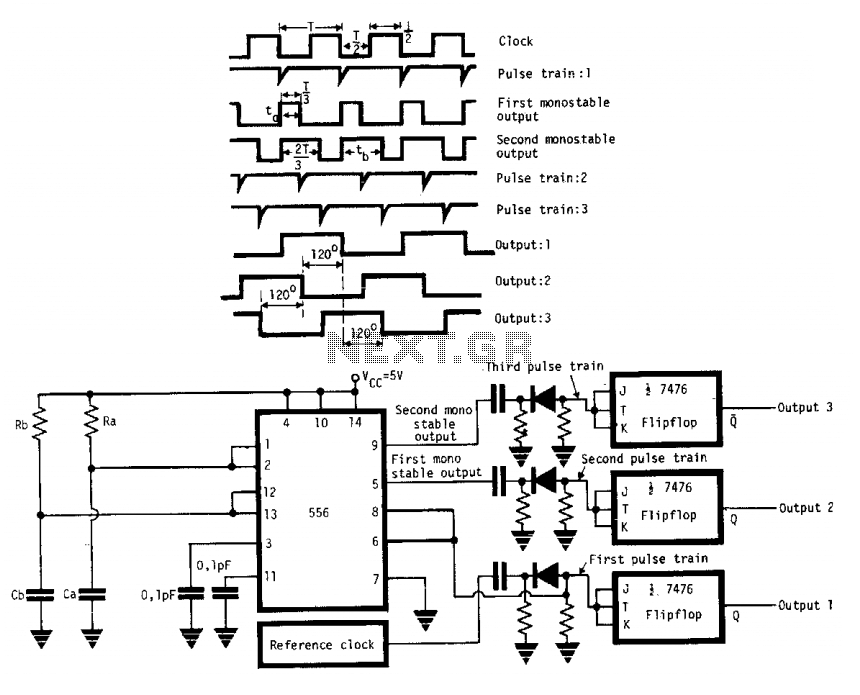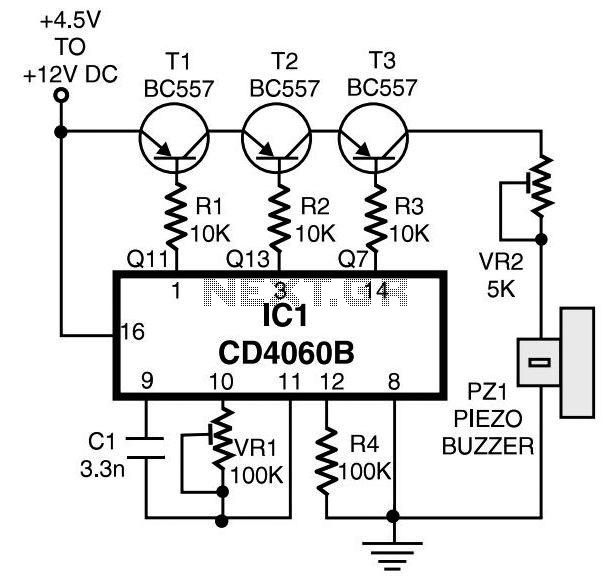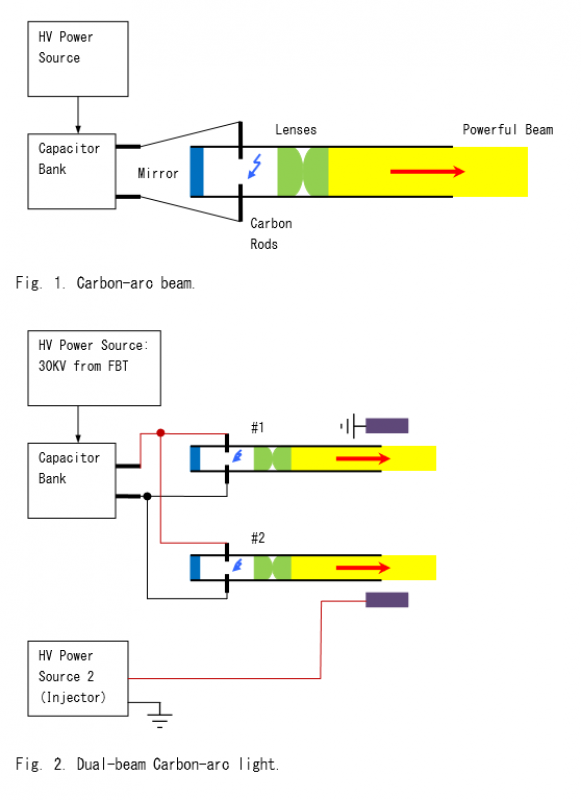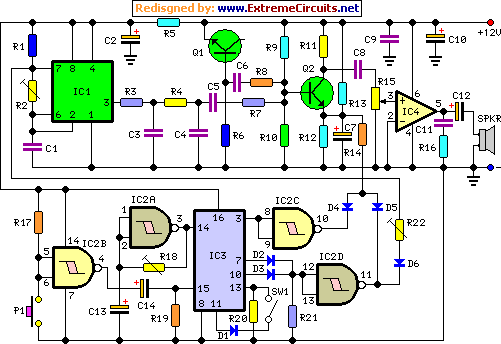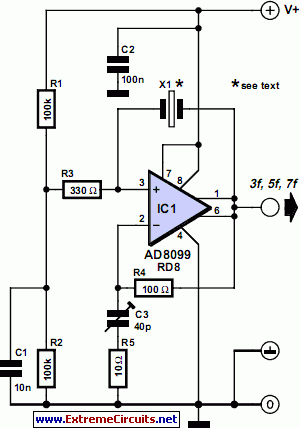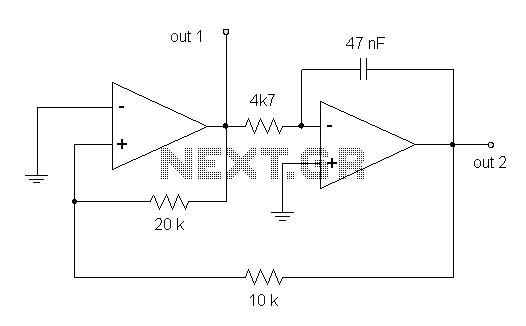
Sine-Wave Generator
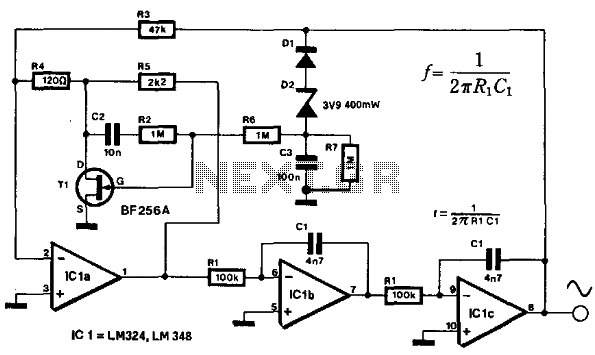
Cascading two identical integrators results in an overall phase shift of 180° and an amplification of unity, provided that the frequency is 1/2kRiCi. This configuration serves as an ideal basis for an oscillator. The two integrators are connected in the feedback circuit of an amplifier, with the gain determined by the amplitude of the output signal. Consequently, the generator maintains a reasonably stable output voltage of approximately 4.5 Vpp. The frequency of the generator is dictated by integrators IC1B and IC1C. An integrator exhibits two characteristics utilized in this design: a 90° phase shift between the input and output (disregarding the non-ideal behavior of the operational amplifier) and an amplification factor of -1. With the specified values of CI (CI") and RI (RI"), the output frequency is approximately 300 Hz. The frequency can be adjusted by replacing RI and RI" with a stereo potentiometer, with the overall range of this potentiometer limited to not exceed a decade. The maximum achievable frequency is around 5 kHz, and distortion remains below 0.1%. The generator draws a current of only a few milliamperes. The LM348 is a quadruple 741 operational amplifier, allowing the construction of the generator using four 741s.
Cascading two identical integrators creates a feedback loop that results in a phase shift of 180 degrees, which is essential for generating oscillations. The configuration is designed to ensure that the output signal maintains a stable voltage level, typically around 4.5 V peak-to-peak (Vpp). The operational frequency of the oscillator is primarily influenced by the capacitors and resistors used, specifically CI and RI, with the relationship defined as frequency = 1/(2πRC) for the integrators.
In this design, the operational amplifiers (op-amps) used are configured as integrators, which inherently provide a 90-degree phase shift between the input and output signals. This characteristic is crucial for achieving the desired oscillation. The design takes advantage of the negative feedback provided by the integrators, which results in a stable output.
The output frequency can be fine-tuned by substituting fixed resistors RI and RI" with a stereo potentiometer. This adjustment capability allows for flexibility in the oscillator's frequency range, which should ideally remain within a decade to ensure consistent performance. The maximum frequency that can be achieved with this configuration is approximately 5 kHz, while maintaining distortion levels below 0.1%, indicating high fidelity in the output signal.
The current consumption of the oscillator is minimal, drawing only a few milliamperes, which makes it suitable for battery-operated applications. The use of the LM348, which contains four 741 op-amps, facilitates the construction of the oscillator circuit without requiring additional components, thus simplifying the overall design. This versatility allows for the integration of multiple functions within a single package, enhancing the efficiency of the circuit design. Cascading two identical integrators will thus result in an overall phase shift of 180° and an amplification of unity (p rovided that the frequency is 1/2kRiCi): an ideal basis for an oscillator. The two integrators are connected in the feedback circuit of an amplifier whose gain is determined by the amplitude of the output signal. Consequently, the generator has reasonably stable output voltage (at a level of about 4.5 Vpp). The frequency of the generator is determined by integrators IC1B and IC1C. An integrator has two properties that are used in this design. Firstly, a phase shift of 90° is between the input and output (ignoring, for the moment, the nonideal behavior of the op amp), and secondly, its amplification is -1.
With the values of CI (CI") and RI (RI"), as shown in the diagram, the output has a frequency of about 300 Hz. The frequency can be varied by replacing RI and RI" with a stereo potentiometer. To keep the frequency setting within bounds, the overall range of this potentiometer should not exceed a decade.
The maximum attainable frequency is about 5 kHz. Distortion is not greater than 0.1%. The current drawn by the generator is only a few milliamperes. Finally, the LM348 is a quadruple 741; it is thus possible to construct the generator from four 741s. 🔗 External reference
Cascading two identical integrators creates a feedback loop that results in a phase shift of 180 degrees, which is essential for generating oscillations. The configuration is designed to ensure that the output signal maintains a stable voltage level, typically around 4.5 V peak-to-peak (Vpp). The operational frequency of the oscillator is primarily influenced by the capacitors and resistors used, specifically CI and RI, with the relationship defined as frequency = 1/(2πRC) for the integrators.
In this design, the operational amplifiers (op-amps) used are configured as integrators, which inherently provide a 90-degree phase shift between the input and output signals. This characteristic is crucial for achieving the desired oscillation. The design takes advantage of the negative feedback provided by the integrators, which results in a stable output.
The output frequency can be fine-tuned by substituting fixed resistors RI and RI" with a stereo potentiometer. This adjustment capability allows for flexibility in the oscillator's frequency range, which should ideally remain within a decade to ensure consistent performance. The maximum frequency that can be achieved with this configuration is approximately 5 kHz, while maintaining distortion levels below 0.1%, indicating high fidelity in the output signal.
The current consumption of the oscillator is minimal, drawing only a few milliamperes, which makes it suitable for battery-operated applications. The use of the LM348, which contains four 741 op-amps, facilitates the construction of the oscillator circuit without requiring additional components, thus simplifying the overall design. This versatility allows for the integration of multiple functions within a single package, enhancing the efficiency of the circuit design. Cascading two identical integrators will thus result in an overall phase shift of 180° and an amplification of unity (p rovided that the frequency is 1/2kRiCi): an ideal basis for an oscillator. The two integrators are connected in the feedback circuit of an amplifier whose gain is determined by the amplitude of the output signal. Consequently, the generator has reasonably stable output voltage (at a level of about 4.5 Vpp). The frequency of the generator is determined by integrators IC1B and IC1C. An integrator has two properties that are used in this design. Firstly, a phase shift of 90° is between the input and output (ignoring, for the moment, the nonideal behavior of the op amp), and secondly, its amplification is -1.
With the values of CI (CI") and RI (RI"), as shown in the diagram, the output has a frequency of about 300 Hz. The frequency can be varied by replacing RI and RI" with a stereo potentiometer. To keep the frequency setting within bounds, the overall range of this potentiometer should not exceed a decade.
The maximum attainable frequency is about 5 kHz. Distortion is not greater than 0.1%. The current drawn by the generator is only a few milliamperes. Finally, the LM348 is a quadruple 741; it is thus possible to construct the generator from four 741s. 🔗 External reference
